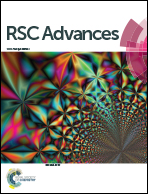Elucidation of the mechanisms governing the thermal diastereomerization of bioactive chiral 1,3,4-thiadiazoline spiro-cyclohexyl derivatives towards their anancomeric stereoisomers†
Abstract
The kinetics of the thermal isomerization of some diastereomers of three chiral 1,3,4 thiadiazoline derivatives, selected as case studies of structures resulting from mono-alkyl substitution of the anancomeric 4-acetyl-2-acetamido-1,3,4-thiadiazolinyl-spiro-cyclohexane (TsC) framework, have been investigated in order to elucidate the possible mechanistic pathways and the structural factors responsible for the observed spiro-junction lability. The insertion of a methyl or a t-butyl group on the C2 or C3 position with respect to the spiro junction generates two stereogenic centres, so that two pairs of enantiomers exist. The first-order rate constants for the isomerization of the less stable enantiomers into the most stable ones have been measured in different solvents and at different temperatures through batch-wise kinetic determinations. The obtained data have been successfully rationalized by DFT calculations and Linear Solvation Energy Relationships (LSER) analyses. The achieved elucidation should make it possible to plan a more rational synthesis of this kind of pharmacologically active compounds, thus affording a practical tool that is useful for controlling the involved stereochemistry and spiro-junction lability.



 Please wait while we load your content...
Please wait while we load your content...